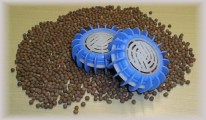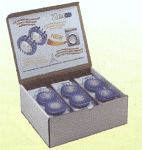
 |
: how it works |
|
The first zeolite to be discovered were the stilbite, in 1756, by a Swedish mineralogist Cronsted, who during a study of this mineral, which was unknown at that time, noticed how, submitted to flame heating it generated a new process known as intumescence. This phenomenon which takes place for many zeolites, makes it possible for them, under flame heating, a fast removal of the water they contain, so fast to give a visual effect as though the mineral were boiling. The name zeolite comes from this behaviour, from the Greek "zeo" which means boil and "lithos" meaning stone. |
 |

|
Zeolites are wide channels minerals (mono-, bi-, or three dimensional) with controlled porosity where the water molecules are placed. Their feature is the variable content of water which evaporates, with heating, without the crystal undergoing any change; indeed, placed in a humid atmosphere, the crystal absorbs the initial water content. In the dehydrated crystal, the place already occupied by water can be taken by molecules, mainly Calcium and Magnesium molecules. By taking away Calcium and Magnesium from water zeolites and therefore also ZEO, reduce the total hardness. The washing machine working cycle allows to zeolites to "operate" at best; indeed, with washing machine water heating, zeolites of ZEO give out the water they contain, removing the minerals of Calcium and Magnesium Carbonate from water and making the water less hard and allowing to wash with less detergent; finally, when the cycle is completed they reacquire the previously loosen water re-hydrating and preparing themselves to a new washing cycle. |
|
Zeolites are defined also as molecular sifter, as the sizes of channels allow the inlet of molecules having a diameter little smaller than pores. Zeolites are always more present in modern detergents where they replace ionic surface-active which, chemically reduce water hardness therefore in an unnatural way. The presence of hardness ions (Calcium and Magnesium) in the water used, strongly affects the washing results. Indeed, the detergent action of any surface-active, is strongly diminished by the presence of Calcium and Magnesium ion, as its solubility, and therefore its efficiency, is decisively reduced. For this reason, the quantity of detergent to be used for each washing cycle must be evaluated according to he water hardness, and a hardness reduction allows to wash with less detergent. |
 |
|
|
webwork
by netcowork |
copyright © 1998- all rights reserved. |